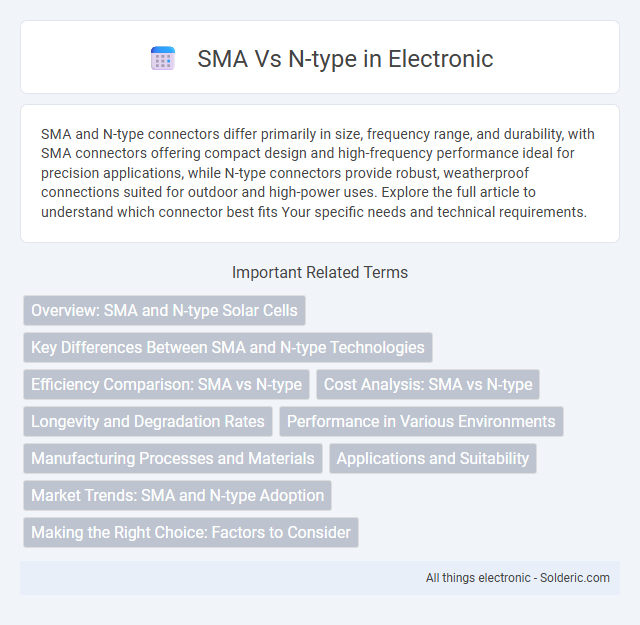SMA and N-type connectors differ primarily in size, frequency range, and durability, with SMA connectors offering compact design and high-frequency performance ideal for precision applications, while N-type connectors provide robust, weatherproof connections suited for outdoor and high-power uses. Explore the full article to understand which connector best fits Your specific needs and technical requirements.
Comparison Table
| Feature | SMA Connector | N-Type Connector |
|---|---|---|
| Frequency Range | Up to 18 GHz (25 GHz for precision versions) | Up to 11 GHz (some types up to 18 GHz) |
| Size | Small, 8 mm diameter | Larger, approx. 21 mm diameter |
| Impedance | 50 Ohms | 50 Ohms or 75 Ohms |
| Cable Compatibility | Typically RG-58, RG-142 | Typically larger coaxial cables (e.g., LMR-400) |
| Power Handling | Up to 500 watts | Up to 5000 watts |
| Use Cases | RF Test Equipment, Microwave Systems | Outdoor Antenna Applications, Base Stations |
| Environmental Rating | Moderate, limited weather resistance | Weatherproof, suitable for outdoor use |
| Connection Type | Threaded, screw-on | Threaded, screw-on with gasket seal |
Overview: SMA and N-type Solar Cells
SMA solar cells utilize Single-crystalline Microcrystalline Architecture to enhance light absorption and carrier mobility, resulting in improved efficiency over conventional designs. N-type solar cells are based on n-doped silicon substrates offering higher tolerance to impurities and better performance under high temperatures, leading to enhanced durability and energy yield. Both SMA and N-type technologies optimize photovoltaic conversion by targeting distinct material properties to maximize solar energy harvesting.
Key Differences Between SMA and N-type Technologies
SMA and N-type connectors differ primarily in size, frequency range, and application suitability. SMA connectors offer excellent performance up to 18 GHz, making them ideal for high-frequency RF applications, while N-type connectors support lower frequencies, typically up to 11 GHz, and excel in robust outdoor environments due to their weather-resistant design. Your choice between SMA and N-type depends on factors such as frequency requirements, durability needs, and connector size constraints.
Efficiency Comparison: SMA vs N-type
N-type solar cells generally exhibit higher efficiency compared to standard SMA (Standard Monocrystalline Alloy) panels due to lower recombination rates and better tolerance to impurities. The improved electronic properties of N-type cells lead to increased power conversion efficiency, often exceeding 22%, while SMA panels typically range around 18-20%. Choosing N-type technology can enhance Your solar system's overall energy yield and long-term performance.
Cost Analysis: SMA vs N-type
SMA connectors generally offer a lower cost solution compared to N-type connectors due to their smaller size and simpler construction, making them ideal for applications where budget constraints are critical. N-type connectors, while more expensive, provide superior performance with higher power handling and better weather resistance, justifying the investment for outdoor or high-frequency applications. Cost analysis between SMA and N-type connectors should weigh initial purchase price against long-term durability and performance requirements.
Longevity and Degradation Rates
SMA connectors typically exhibit higher longevity with corrosion-resistant materials ensuring stable performance over extended periods, whereas N-type connectors may experience faster degradation in harsh environments due to less robust sealing. The degradation rates of SMA connectors are generally lower, making them ideal for applications demanding long-term reliability and minimal maintenance. Your choice between SMA and N-type should consider environmental exposure and expected service life to optimize connection durability.
Performance in Various Environments
SMA connectors exhibit robust performance in harsh environments, with excellent resistance to vibration and moisture, making them ideal for outdoor and industrial applications. N-type connectors provide superior power handling and lower signal loss at higher frequencies, excelling in demanding RF and microwave communications, especially in temperature-extreme conditions. Both connector types offer reliable performance in diverse environmental conditions, but SMA connectors are often preferred for compact, precision applications while N-type connectors dominate in high-power, rugged setups.
Manufacturing Processes and Materials
SMA connectors are typically manufactured using brass or stainless steel with a gold or nickel plating, ensuring durability and excellent corrosion resistance. N-type connectors employ precision-machined brass or stainless steel with PTFE dielectric, offering higher power handling and consistent performance at microwave frequencies. Your choice between SMA and N-type depends on the specific manufacturing qualities needed, such as size constraints or environmental robustness.
Applications and Suitability
SMA connectors are widely used in RF applications requiring high durability and consistent performance up to 18 GHz, making them suitable for antennas, test equipment, and microwave systems. N-type connectors offer superior power handling and weather resistance, ideal for outdoor cellular base stations and radar systems operating up to 11 GHz. You should choose SMA connectors for compact, precision devices, while N-type is better for robust, high-power environments.
Market Trends: SMA and N-type Adoption
SMA connectors dominate the market due to their reliability and wide usage in RF applications, while N-type connectors gain traction in high-power and outdoor environments for enhanced durability and performance. Market trends indicate an increasing adoption of N-type connectors in telecommunications and 5G infrastructure, driven by demand for robust, weather-resistant solutions. Your choice between SMA and N-type should consider application-specific requirements, balancing frequency range, power handling, and environmental factors.
Making the Right Choice: Factors to Consider
When choosing between SMA and N-type connectors, consider factors such as frequency range, power handling, and application environment. SMA connectors excel in high-frequency applications up to 18 GHz and compact designs, while N-type connectors handle higher power and outdoor conditions with excellent weather resistance. Your decision should prioritize the specific requirements of your RF system for optimal performance and durability.
SMA vs N-type Infographic

 solderic.com
solderic.com